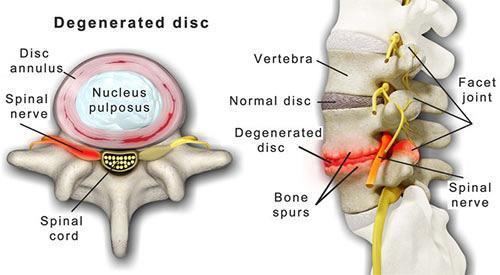Your spine is a remarkable structure. It supports your body, allows movement, and protects your spinal cord. At the center of its function are small but vital structures called intervertebral discs—rubbery cushions between the bones of the spine that act as shock absorbers. Over time, though, these discs naturally wear down, and in some people, that wear and tear can become painful. This condition is known as Degenerative Disc Disease, or DDD.
At Adam Vital Hospital, we see this condition frequently—especially in patients over the age of 40. But here's the truth: while the term “disease” sounds alarming, degenerative disc disease is not a disease in the traditional sense. It's a condition related to aging, genetics, lifestyle, and sometimes injury. And with the right care, it can be managed effectively.
What Is Degenerative Disc Disease?
Degenerative Disc Disease refers to the gradual deterioration of the intervertebral discs in the spine. These discs are made of a tough outer layer (annulus fibrosus) and a gel-like inner core (nucleus pulposus). As we age, the discs lose hydration, elasticity, and thickness. This can lead to reduced cushioning, instability, and—in some cases—pain.
The most common areas affected are the lumbar spine (lower back) and the cervical spine (neck), since these areas experience the most movement and stress.
What Causes It?
The primary cause is natural aging, but several other factors can accelerate disc degeneration:
Repetitive stress or injury to the spine
Poor posture or prolonged sitting
Obesity, which increases pressure on the spine
Smoking, which reduces blood flow to spinal tissues
Genetic predisposition—some people are simply more prone to disc degeneration
Manual labor or high-impact sports, over time
It's important to note that almost everyone experiences some disc degeneration as they age, but not everyone develops symptoms.
Signs & Symptoms
The symptoms of degenerative disc disease can vary from mild to severe. Some people may not feel any pain at all, while others may experience daily discomfort or limited mobility.
Common symptoms include:
Persistent back or neck pain that worsens with movement or prolonged sitting
Intermittent pain that comes and goes
Pain radiating to the arms or legs if the disc affects nearby nerves
Tingling, numbness, or weakness in the limbs
Reduced flexibility or stiffness in the spine
Pain relief when changing positions (such as lying down or walking)
In more advanced cases, DDD may contribute to herniated discs, spinal stenosis, or facet joint arthritis.
How Is It Diagnosed?
At Adam Vital Hospital, we take a comprehensive approach to diagnosis. It begins with a detailed patient history, followed by a physical examination to assess mobility, posture, and nerve function.
If we suspect disc degeneration, imaging tests such as:
X-rays (to show disc space narrowing)
MRI scans (to see the condition of discs, nerves, and surrounding tissues)
CT scans in complex cases
are used to confirm the diagnosis and rule out other causes.
Our specialists also evaluate whether the pain is truly caused by disc degeneration, since back pain can stem from multiple sources.
Treatment Options
There is no "cure" for degenerative disc disease, but most people respond very well to conservative treatment. Our goal is to reduce pain, improve function, and slow progression.
1. Physical Therapy
A core part of treatment, PT helps to strengthen the muscles that support the spine, improve posture, and increase flexibility. At Adam Vital, our expert physiotherapists tailor programs to each patient's specific condition and lifestyle.
2. Pain Management
This includes:
Anti-inflammatory medications (NSAIDs)
Muscle relaxants, if spasms are present
Epidural steroid injections for more severe inflammation
Nerve blocks, in certain cases
We take a conservative approach, avoiding overuse of medications while targeting long-term relief.
3. Lifestyle Modifications
Sometimes, small changes can bring big results. This might involve:
Weight loss to reduce pressure on discs
Ergonomic adjustments at work
Stopping smoking
Activity modification and safe exercise habits
4. Minimally Invasive Procedures
For patients who don't respond to therapy or medications, advanced techniques such as:

Radiofrequency ablation (to disable pain-causing nerves)
Disc decompression procedures
can offer significant relief without major surgery.
5. Surgical Treatment
Surgery is typically a last resort, reserved for cases with severe, unmanageable pain or nerve damage. Common procedures include:
Discectomy – removing the damaged portion of the disc
Spinal fusion – fusing two vertebrae to stabilize the spine
Artificial disc replacement – replacing the damaged disc with a synthetic one
Our spine surgeons use minimally invasive techniques whenever possible to reduce downtime and enhance recovery.
Living with Degenerative Disc Disease
DDD is a chronic condition, but that doesn't mean you have to live in pain. With the right care, many people return to active, fulfilling lives. The key lies in early intervention, consistent management, and regular monitoring.
At Adam Vital Hospital, we don't just treat symptoms—we focus on the whole person. That includes education, emotional support, and long-term guidance.
Conclusion
Our Spine and Orthopedic Centre is one of the leading centers for spinal health in Dubai. From diagnosis to rehabilitation, we offer comprehensive, multidisciplinary care under one roof—combining modern imaging, advanced therapies, and personalized rehabilitation programs.
Whether you're dealing with chronic back pain or newly diagnosed Degenerative disc issues, we're here to help you move better, live stronger, and feel like yourself again.
Experiencing chronic back pain? Let Adam Vital Hospital help you find clarity, comfort, and a custom treatment plan that works. Book your spine assessment today.





